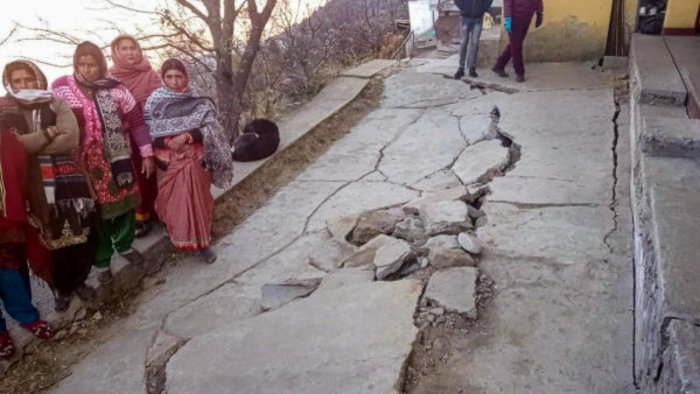
Manas Dasgupta
NEW DELHI, Jan 11: Even as thousands of people are living in fear in the “sinking” pilgrim town of Joshimath in Uttarakhand, known to be the gateway to Badrinath, banned drilling activities have restarted in the dead of the night.
And they do not bother to keep any veil of secrecy over the illegal activities. The noise from the drilling could be heard for over a kilometre but there was no one to stop the workers. Several media teams caught on camera the illegal stone-crushing and drilling that was found going on in full swing in the mountains just outside Joshimath, near the highway that connects the area to the holy town of Badrinath. Cranes were seen carrying stones from the spot after the crushers did their job.
All construction work has been banned in and around Joshimath due to land subsidence which has caused dangerous cracks in 721 houses in the town. Work on an all-weather road was also stopped and the people are living in constant fear as any time the Himalayan town may collapse.
Officials admit that the “sinking town” of Joshimath is on the brink of disaster with cracks in hundreds of buildings. The scale of damage is most visible at the Jaypee power plant, currently the most dangerous building in town. Because of the extent of destruction at the residential complex of Jaypee, people have been banned from entering the campus.
At the badminton court, the cracks in the walls are so wide that a human hand can slip in. The floors are sagging, and the windows are askew in the complex. The doors are barely hanging off hinges and parts of the roof are crumbling. Some of the rooms are barely standing. A light nudge can bring the wall crashing down. In the toilet, the floor has caved.
The entire complex has been declared a “red zone” – which indicates most dangerous – and it is widely believed by locals as well as experts that the residential building could collapse any minute. Residents say for the past few days, ground water has been gushing beneath the surface at a high speed, and it is this water that has weakened the walls and floors. Cracks in buildings are oozing this brown muddy water.
Across the temple town massive cracks have appeared in buildings and roads after years of unplanned infrastructure building, including hydropower projects. Many have fled their homes and around 600 houses and hotels are sinking in the town of around 20,000 people.
Thousands of residents are being evacuated to safety. The state government will demolish the most damaged buildings in the next few days. But despite the threat, the demolition of the most damaged buildings including two hotels and several houses, was blocked on Tuesday by angry residents and shop-owners who said they were not given any notice. Besides hotels and business establishments, 678 homes are in danger, the Uttarakhand government has said. Some 4,000 people have been moved to relief camps after a satellite survey.
Local residents staged a massive protest against the Uttarakhand Government over the demolition of Malari Inn Hotel, which has been declared “unsafe” by the district administration. The protestors demanded four times the compensation of the present value of the damaged buildings. The State and residents failed to reach a mutual agreement on the terms.
Joshimath and its neighbouring areas have been sinking at the rate of 6.5 cm every year, satellite data reveals. Many local residents blame the hydroelectricity project of the National Thermal Power Corporation (NTPC), alleging that the blasting of tunnels left the entire region unstable. The NTPC has denied the charge.
The town also hosts a major Indian army base and a strategic road to the disputed border with China that has also reportedly developed wide cracks. The region is prone to earthquakes and has seen disasters in recent years blamed on melting glaciers and incessant construction and drilling in the mountains. In 2021, at least 200 people were killed in flash floods in Joshimath and surrounding areas in a disaster partly blamed on excessive development.
Meanwhile, the Uttarakhand Chief Minister Pushkar Singh Dhami on Wednesday announced ₹1.5 lakh immediate compensation to be given to all the affected families in Joshimath. The compensation will be initially given to those who are displaced.













